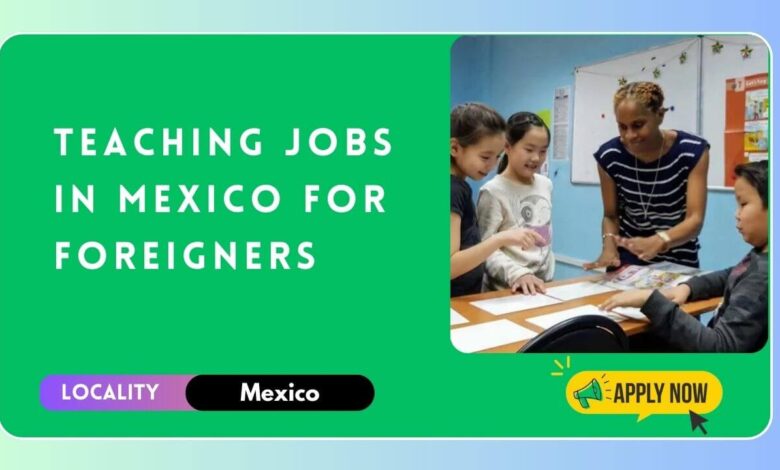Teaching Jobs in Mexico for Foreigners 2025 – Visa Sponsorship

There are numerous methods for foreign nationals to obtain a visa and labor in Mexico. A visa is required for individuals who are not citizens of the country and wish to engage in employment. For instance, individuals employed by Mexican organizations necessitate a resident visa that includes work authorization. People who have worked for a foreign company in Mexico for less than six months are also eligible for a working visitor’s visa.
Mexico is home to a massive number of businesses that manufacture a variety of commodities, including food and beverages, automobiles, silver, iron, steel, chemicals, pharmaceuticals, and electronics.
Check Also: ESL Teacher Jobs in Italy with Visa Sponsorship
List of Teaching Jobs in Mexico for Foreigners:
1. Early Childhood Assistant Teacher
PRIMARY FUNCTIONS:
- Assists the lead teacher in the formulation and implementation of the curriculum within the established boundaries.
- Assists in the development and execution of daily instruction and activity plans.
- Assist the Program Director/Lead Teacher in guaranteeing that the participant/staff ratios are in accordance with state regulations.
- Assist the Program Director/lead teacher in the planning and preparation of a creative learning environment, which includes the establishment of centers of interest and the provision of essential materials and supplies.
- Responsible for the classroom, the pupils, and all activities.
- Consistently and meticulously evaluates and observes each child.
2. Bilingual Coordinator, Teacher Education
Responsibilities and Duties
- Oversees the bilingual and dual credit cohorts for early childhood.
- Students are actively solicited for programs.
- Dual credit options for early childhood are consistently monitored.
- Provides guidance to students regarding their academic achievements and learning objectives.
- Collaborates with the Tutoring Center and Counseling/Special Services to refer students as necessary.
- Upholds the accreditation standards for programs.
- Adheres to the deadlines for mandatory reports.
Benefits of Teaching Jobs:
- Influence on Students: One of the most rewarding aspects of teaching is the opportunity to make a positive impact on students’ lives by imparting knowledge, fostering critical thinking, and inspiring a passion for learning.
- Satisfaction at Work: Knowing that they are assisting students in achieving their academic and personal objectives provides a sense of fulfillment for many educators.
- Continuous Education: Frequently, teaching requires keeping abreast of developments in your field, which can contribute to personal and professional development.
- Work-life equilibrium: In comparison to other professions, teaching positions typically offer a more favorable work-life balance due to their structured schedules and lengthy vacation periods.
- Job Protection: In several nations, teaching positions are in high demand and offer a degree of job security and stability.
- Advantages Package: Teachers may receive benefits such as healthcare, retirement plans, and paid leave, depending on the educational institution and location.
- Vacations and summers off: Typically, teachers have extended breaks during the holidays and summer, allowing for leisure and personal pursuits.
- Profession Advancement: There are opportunities for advancement in teaching careers, including those of department chief, curriculum coordinator, and administrator.
- The creative process: Teachers are frequently able to design their own courses and classroom activities, allowing them to express their creativity in their work.
- Participation in Society: Teaching is a meaningful profession because it contributes directly to the development and education of future generations.
- Education and Reading: Education and literacy are essential for the advancement and well-being of society, and teachers play a crucial role in promoting them.
- Human Resource Development: An educated population contributes to a skilled workforce, which is critical for economic development and competitiveness.
- Civic Participation: Education promotes civic engagement and informed citizenship, resulting in a society that is more participatory and informed.
- Innovation and Advancement: Individuals with a higher level of education are more likely to contribute to scientific and technological advances, thereby fostering innovation and progress.
- Economic Mobility: Education provides opportunities for social mobility, allowing individuals to enhance their socioeconomic standing.
- Heritage Conservation: Teachers frequently contribute to the preservation of cultural heritage and traditions by transmitting knowledge and values to new generations.
- Community Development: Schools and educational institutions serve as community hubs, drawing people from various backgrounds together and fostering social cohesion.
- Problem Resolution: Individuals with a higher level of education are better equipped to face societal challenges and overcome complex problems.
Mexico work permit:
According to Mexican immigration law, in order to legally labor in Mexico in exchange for compensation, a foreign national must obtain a valid work visa. Immigration officers conduct a verification and inspection process prior to issuing the visa.
Mexico Work Visa Types:
The following are the most significant categories of work visas for Mexico, which enable a foreign individual to enter the country and, in certain circumstances, work.
Non-Working Tourist Visa:
This visa is also known as the “Visitor Visa.” It does not authorize or authorize the performance of remunerated activities in Mexico. Consequently, it is advantageous for individuals who intend to remain in Mexico for a brief duration, as they are not required to obtain permission to participate in activities that generate substantial income in the country. The visa is not eligible for extension or conversion into a working visa, and the foreign national is permitted to remain in the country for a maximum of 180 days.
Working Visitor Visa:
This visa, which is also referred to as a “visitor visa,” enables you to earn a living in Mexico. This is a common type of visa that foreign nationals grant to work temporarily in Mexico. The foreigner is permitted to labor in Mexico and remain in the country for a period of 180 days. This visa is not convertible into a working visa or extendable. After obtaining permission from the National Immigration Institute, this visa is issued and can only be obtained from a Mexican Consulate or Embassy.
Temporary Resident Visa:
The temporary resident visa, also referred to as the “Residente Temporal” visa, is issued to personnel who intend to work in Mexico for a period exceeding 180 days but less than four years. The visa is exclusively available to personnel who have a long-term contract with a Mexican company. In order to obtain a Residente Temporal permit, this visa is issued. The Temporary Resident Permit must be applied for by the visa holder within 30 days of their arrival in the country. Additionally, employees who possess this visa are permitted to enter and exit the country on numerous occasions.
Only individuals who have purchased real estate, been invited to work by a Mexican company, made investments in Mexico, or have families in the country are eligible for a temporary resident permit.
This visa may be extended for a maximum of four years. The transient resident visa is not eligible for renewal after four years; however, it may be converted to a permanent residence visa upon request.
Permanent Resident Visa:
This is also referred to as the Visa de Residente Permanente, and it enables international travelers to remain in Mexico indefinitely. This visa is suitable for individuals who aspire to obtain permanent residency in Mexico or eventual Mexican citizenship. In order to qualify for this visa, the applicant must possess sufficient income to sustain themselves and have family connections in Mexico. Conversely, they must have maintained temporary residency status for four consecutive years.
Mexico Work Permit Requirements:
In order to work in Mexico, the majority of employees will require a permanent resident visa. Nevertheless, not all employees are eligible for a permanent resident visa. Requirements include four years of regular status as a temporary residence visa holder, an adequate monthly income, and family connections in the country.
In this case, businesses should apply for a temporary resident permit on behalf of their employees to enable them to operate in Mexico.
Although some requirements may differ, it is essential to submit a number of fundamental documents when applying for a work visa in Mexico. The following are as follows:
- Visa application form
- A passport that is currently valid is necessary.
- A duplicate of the migration document
- Identification with a photograph is mandatory.
- An invitation issued by a private or public institution
- Valid evidence of one’s financial status, employment, and affiliation with the Mexican government
Mexico Work Permit Application Process:
- Firms are required to extend an employment offer to the foreign employee prior to submitting an application for a work visa in Mexico. The issuance of the position will indicate that the company in Mexico intends to employ a foreign national. According to the Federal Labor, the employer is required to have 10% of the company organization owned by foreign nationals, and technical positions held by foreign nationals cannot be filled by a Mexican native.
- General information regarding the position, including activities, work duration, and compensation, must be included in the offer letter.
- The company must subsequently submit all necessary documentation to the INM in order to obtain a work permit for all foreign employees. The application will be approved upon completion of the INM verification and company analysis. The approval status typically appears within 30–45 days. Upon approval, a letter is dispatched to both the international employee and the employer.
- Upon receipt of the work permit, the employee is required to submit the visa application and documents to the embassy. The consulate arranges a visa interview after the documentation has been resolved. Additionally, the results of the medical examination must be submitted prior to the interview. Five days prior to the interview, it is mandatory to conduct a staff inspection.
- Upon successful completion of the interview, the employee may retrieve their work permit and visa from the consulate. Subsequently, the employee will be required to travel to Mexico. The Migration Official will verify the duration of foreign employees’ stay upon their arrival, contingent upon the type of visa they possess.
- The foreign employee and their family are required to register with the INM within 30 days of their arrival. Family members are required to submit an application for a dependent visa and, if they intend to work, a distinct application for a work permit in Mexico.
- The employee must commence the employment arrangement with the employer for the duration of their stay after registering their presence in Mexico.
Frequently Asked Questions:
How can I become a teacher in Mexico?
Applicants for university English teaching jobs in Mexico will often need to have a Master’s degree in addition to an ESL teaching qualification, such as a TESOL or TEFL certificate. To teach in Mexico’s international schools, educators will need a valid teaching license in their home state or country.
In Mexico, are teachers well paid?
The best average salaries received by entry-level teachers were in Baja California Sur ($11.8k MX), Chiapas ($11.1k MX), and Michoacán de Ocampo ($10.9k MX), while the workforce was larger in Estado de México (167k), Veracruz de Ignacio de la Llave (96.7k), and Jalisco (78.5k).
How much do international teachers make in Mexico?
In Mexico, TEFL teachers can find jobs in public schools, international schools, language schools, universities, in-company, and privately. In schools, the average salary ranges from $7,000 to $18,000 MXN (400 to $1,000 USD).



